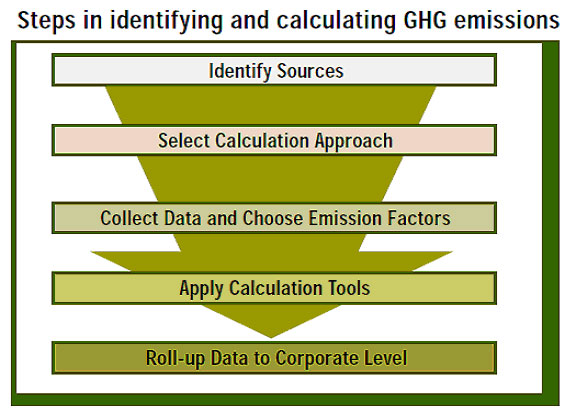Hundreds of companies already calculate their emissions of CO2 and other so-called greenhouse gasses, but the challenge is large. Many of these companies, as well as other governments or organizations, use the standards and tools developed by the Greenhouse Gas Protocol as a key element in developing those calculations.
There are a number of different guidelines or “protocols” for developing those calculations. The most prominent include The Greenhouse Gas Protocol (the most widely adopted), EPA Climate Leaders, The Climate Registry, and the International Organization for Standardization’s ISO 14064 (which is largely based on the Greenhouse Gas Protocol).
In this article, we look specifically at The Greenhouse Gas Protocol (GHG Protocol). The GHG Protocol is a non-profit organization that has created a set of standards and tools that companies can use to calculate their emissions of greenhouse gases such as CO2 at multiple levels (individual products, factories, the corporation). These tools include general guidelines as well as industry-sector (e.g., paper and paper) and activity-specific (e.g., emissions from transport or mobile sources) methodologies that are available in free, downloadable spreadsheets. (See also: CO2 Emissions Tracking and Monitoring Will be Key to Green Supply Chain Progress.)
The Greenhouse Gas Protocol has become the most recognized and standard way for companies to achieve the difficult task of calculating direct and indirect emissions levels. It attempts to apply the same type of “generally accepted accounting principles” used in the financial world to the calculation of greenhouse gas emissions. The goal, in part, is to drive accuracy and consistency in reporting within and between entities, which then obviously gives companies an information platform that can be used to reducing emissions over time.
The GHG Protocol was established in 1998 by the World Business Council for Sustainable Development (WBCSD) in Geneva, Switzerland and the World Resources Institute (WRI) in Washington, DC, two environmentally-focused organizations that jointly administer the GHG Protocol program. The program is funded by a variety of organizations and foundations, such as the British Petroleum, Alcoa Foundation, and the US Environmental Protection Agency, among several others.
The organization’s mission is to standardize the calculation of greenhouse gas emissions and provide tools to help governments and businesses make those calculations. The GHG Protocol Initiative comprises two separate but linked standards:
- GHG Protocol Corporate Accounting and Reporting Standard (which provides a step-by-step guide for companies to use in quantifying and reporting their GHG emissions); and
- GHG Protocol Project Quantification Standard (a planned guide for quantifying reductions from GHG mitigation projects).
It published its first GHG Protocol Corporate Accounting and Reporting Standard in 2001 and, more recently, issued a second edition of that document. In parallel, the GHG Protocol has worked with a variety of parties to develop standards for industry-sector and application-specific calculation tools, generally in the form of spreadsheets.
In essence, the accounting and reporting framework deals with high level issues around calculating emissions, while the spreadsheet tools provide help in making more granular calculations of emissions from various activities that are then rolled up to a site or corporate number.
All these documents and tools are free with a simple registration on the GHG Protocol website.
Some countries, especially in Europe, already require companies to report GHG emissions, and use of the GHG Protocol is an accepted way of determining those levels. They will most likely be accepted in any sort of Cap-and-Trade program in the US as well.
The GHP Protocol also provides detailed guidance on some tricky issues, such as direct versus indirect emissions associated with a company’s business, how to handle accounting for joint ventures and other fractional ownership of businesses, dealing with acquisitions and divestures (especially for determining “base year” numbers) and other difficult subjects.
It also defines emissions at various levels, classified as follows:
Scope 1: GHG emissions from sources a company owns or controls (e.g., a factory);
Scope 2: Emissions from the generation of purchased electricity that is consumed in its owned or controlled equipment or operations; and
Scope 3: Other indirect or more difficult to calculate emissions, such as the production or purchase of raw materials, inbound and outbound transportation, and even employee travel to and from work.
Actually Calculating Emissions
While the GHP protocol provides many standards for how companies should think about calculating the greenhouse gas emissions, it also partially addresses the hard work of actually making those calculations.
The GHG protocol offers the following model for making those calculations:

This is where the spreadsheet tools come into play, enabling companies to use GHG Protocol factors to determine the production of various greenhouse gases. In the automated worksheet sections, companies can insert activity data into the worksheets and select an appropriate emission factor or factors to make a calculation. For a given site or activity, especially in manufacturing, a company will likely need to use a combination of several of the spreadsheet tools to make a complete calculation.
The worksheets can also be customized to meet unique situations. In most cases, even with the worksheets, a substantial amount of research is generally needed to complete them effectively.
While the standard is designed to help businesses or others develop a verifiable GHG inventory, it does not provide a standard for how the verification process should be conducted.
The GHP Protocol is not the only set of guidelines or tools available, and many software vendors have entered the market with more automated systems. However, the GHP Protocol is likely to remain an important piece of the standards for making greenhouse gas calculations.
Do you use the Greenhouse Gas Protocol? What do you like or not like? How much does it really help? Let us know your thoughts at the Feedback button below. 
TheGreenSupplyChain.com is now Twittering! Follow us at www.twitter.com/greenscm
|